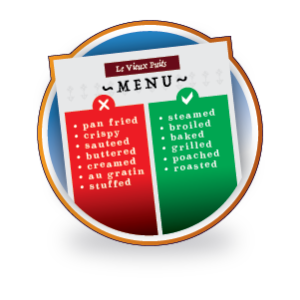We all know cooking at home is healthiest, but sometimes it’s easier—and more fun—to go out. With these tips from Kate Rudisill, MS, RD, LDN, registered dietitian with UNC REX Nutrition Services, you can enjoy date night or a dinner with friends and still stick to a heart-healthy nutrition plan.
 Before You Go…
Before You Go…
- If possible, find the restaurant’s menu online and determine what you plan to order. Having a plan before you get to the restaurant helps you avoid the temptation to make impulsive decisions that might derail your efforts to eat heart-healthy.
Read the Menu Carefully…

- Look first at the “healthy” or “lighter fare” section of the menu, if there is one. But be careful. Just because an item is labeled “healthy” or “light” does not always mean it is heart-healthy. Sometimes the “lighter fare” options are lower in calories but are not necessarily heart-healthy.
- Avoid menu items that are described with any of these words: fried, au gratin, crispy, scalloped, pan-fried, sautéed, buttered, creamed or stuffed.
- Look for foods that are steamed, broiled, baked, grilled, poached or roasted.
 Don’t Be Afraid to Ask Questions
Don’t Be Afraid to Ask Questions
- Pay attention to fat and salt content. Asking the server up front how a dish is prepared can help you decide if it is actually a healthy choice. Olive oil and canola oil are heart-healthy oils. Dishes made with herbs and spices are more desirable than those flavored with salt or salt-based seasonings.
Possible questions to ask: What type of oil is used, and how much? What’s the cooking method? What seasonings are added?
- You can always ask your server to use a healthier cooking option. Just as a person with celiac disease will ask for gluten-free options, if you have heart disease or high blood pressure, you can ask for heart-healthy options. That includes controlling how much oil is used to cook meats or vegetables.
 Think Fish and Fowl
Think Fish and Fowl
- Choose entrees that contain chicken or seafood. Chicken is a lean meat and naturally contains less fat, especially if it is white meat, boneless, skinless and not fried. Fish contains omega-3 fatty acids, which are a healthy source of fat. Rudisill recommends you eat fish one to two times per week for heart health. Choose a grilled, broiled or poached version. Avoid fried seafood.
- Limit red meat for heart health, especially if you have high cholesterol, high blood pressure or other heart issues. Red meat contains saturated fat, while boneless, skinless chicken breast, fish, turkey and lamb contain significantly less fat and typically no saturated fat.
Small Steps Add Up
- Ask for creamy sauces and dressings on the side. You can use just a bit as needed.
- Look for opportunities to make a healthy substitution, such as a side salad instead of French fries, or mustard instead of mayo.
- Enjoy your company, and slow down to avoid overeating. Put down your fork and take a break to gauge your fullness.
- Ask for a to-go box when you order your meal, and put half of it away for later as soon as it arrives.
- Limit eating out to one time per week or less.
With a little bit of effort, you can ensure that the meals you eat away from home are good for your heart.
Want more information about how a dietitian can help you strengthen your heart? Call (919) 784-3419 to schedule an appointment.

